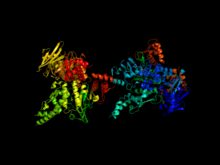Cohesin
| Sister chromatid cohesion protein 1 | |
|---|---|

Cohesin complex composed of
SCC1 and SMC1 proteins. |
|
| Identifiers | |
| Symbol | MCD1 |
| Alt. symbols | PDS3, RHC21, SCC1 |
| Entrez | 851561 |
| PDB | 1W1W |
| UniProt | Q12158 |
| Cohesin subunit SCC3 | |
|---|---|
| Identifiers | |
| Symbol | IRR1 |
| Alt. symbols | SCC3 |
| Entrez | 854786 |
| UniProt | P40541 |
| Structural maintenance of chromosomes protein 1 | |
|---|---|
| Identifiers | |
| Symbol | SMC1 |
| Alt. symbols | CHL10 |
| Entrez | 850540 |
| PDB | 1W1W |
| UniProt | P32908 |
| Structural maintenance of chromosomes protein 3 | |
|---|---|
| Identifiers | |
| Symbol | SMC3 |
| Alt. symbols | J1049 |
| Entrez | 853371 |
| UniProt | P47037 |
Cohesin is a protein complex that regulates the separation of sister chromatids during cell division, either mitosis or meiosis. Cohesins hold sister chromatids together after DNA replication until anaphase when removal of cohesin leads to separation of sister chromatids.
Cohesin is a multi-subunit protein complex, made up of four core subunits: two SMC proteins (SMC1 and 3), an alpha-kleisin (orthologues of yeast Scc1), and an orthologue of the yeast Scc3 protein (e.g. STAG1-3 in humans and SA1-3 in mice).
Smc1 and Smc3 are members of the Structural Maintenance of Chromosomes (SMC) family. SMC proteins have two main structural characteristics: an ATP-binding cassette-like 'head' domain with ATPase activity (formed by the interaction of the N- and C- terminals) and a hinge domain that allows dimerization of SMCs. The head and the hinge domains are connected to each other via long anti-parallel coiled coils. The dimer is present in a V-shaped form, connected by the hinges. Upon ATP binding, the two head domains in the dimer bind to each other, forming a ring structure. ATP hydrolysis can therefore trigger opening and closing of the ring.
Scc1 and Scc3 bind the ATPase domains of Smc1 and Smc3 stabilizing the ring structure. The amino and carboxy terminus of Scc1 bind Smc1 and Smc3. Once Scc1 binds the SMC proteins, Scc3 can also associate by binding with the C-terminal region of Scc1. When Scc1 binds on both Smc1 and Smc3, the cohesin complex forms a closed ring structure. When it binds to only one of the SMC proteins, the complex forms an open ring. Early studies suggested various ways in which cohesin may entrap DNA, including as a monomer that holds both homologues together, and a "hand-cuff" model where two intertwining cohesin complexes each hold one sister chromatid. While some studies support the idea of a hand-cuff model, the model is inconsistent with a number of experimental observations, and is generally considered to entrap chromatin as a monomer.
The topology and structure of these subunits has been best characterized in budding yeast (Haering et al. 2002, 2004), but the sequence conservation of these proteins and biochemical and electron microscopic observations imply that cohesin complexes in other species are very similar in their structure, [1].
...
Wikipedia
